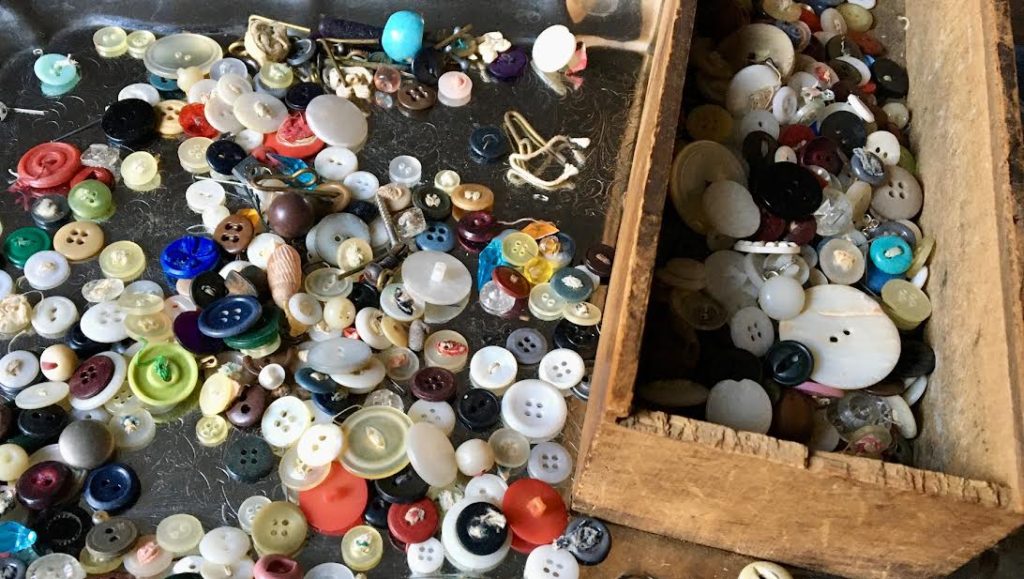
A Column by Donna Cronk
We’d be hard-pressed to find someone who travels over the Whitewater River by sleigh to grandmother’s house, but it’s a safe bet that however we get there, when we visit parents or grandparents—or we’re the parents or grandparents being visited, memories are shared, and stories told.
Recently my sister-in-law Jeannie sent us home with some family heirlooms that belonged to my late brother, Tim. The treasures include a family safe of which our older son, Sam, is now the fifth-generation caretaker; a brass 1908 Model T headlight; a cache of family photos dating to those sleigh days of old, and some other saved objects.
One is a lidded wooden box, the size of a cardboard Velveeta Cheese carton, filled with old buttons. While this surely came from someone in our family, I don’t think it belonged to my mother because I never saw it before. It probably originated with a grandmother or other long-ago ancestor, unearthed from storage in the back of a closet or deep inside a drawer in Fayette, Union, or Wayne County.
I doubt that it’s true of today’s grandmothers, but when I was a kid, I imagine that almost everyone’s grandmother had a button box.
The buttons are unremarkable. Most of them are of the workhorse variety: the small, white matte or pearl-like ones so common to every man’s dress shirt you’ve ever seen; the colorful but plain, flat buttons of many colors from women’s or children’s clothing; and the odd button notable for a design or texture.
It’s obvious that the buttons lived previous lives before they were cut off blouses or pants, then tossed into the box among the others, where they’ve been for decades. Tiny fabric scraps remain attached to the backs of a few. For the most part, there’s a bit of matted, plain fabric. Occasionally, evidence of a pattern is detected, such as the small swatch of red, white and blue plaid, still clinging to one.
I can’t tell you the last time that when I discarded a garment, I first stripped it of buttons and zippers. Now that I think about it, I don’t believe that has ever happened. Sometimes I don’t even save the buttons attached to new clothing for replacements if one would pop off. And even when I do, I don’t know that I’ve ever used the spares.
Our ancestors thought differently about belongings of every kind. At least for working-class folks of the past, which is my family’s heritage, every belonging you owned took a good measure of time and money to buy. They didn’t dispose of anything with wear left in it. If clothing was beyond wearing or handing down, the garment was stripped of buttons and other useful elements such as zippers, and saved.
The stripped clothing then went on to its next purpose: for cutting up for a future quilt, stripping for rags, saving for patching, or the making of doll clothes.
Some buttons in this box were apparently so well used before they were removed that the loops on back are worn in half. Others have chipped edges.
Grandma’s button box is a reminder of our thrifty ancestors. Today we hear what seem to be contemporary terms and concepts as sustainability, recycling, reusing, upcycling, and repurposing. Good advice to not waste energy or consumables.
But grandma practiced that advice as second nature long before those with doctorates in environmental science were born. She knew that being a good steward of what God gave her is part of her citizenship on earth as well as a responsible family member. She knew that it took much personal time and energy to own something new, and that using it up in every way possible only makes sense.
We don’t tend to value that which is easy to come by; easy to replace. Grandma’s humble button box and the buttons inside remind me that there may be a time to come when things aren’t so easy to purchase. They remind me that today we are still called to be good stewards.
Can you imagine your grandmothers chuckling over the idea that caring for what we’re given is a new idea? Here’s to those who came before us and their humble, saved belongings that remind us of the timeless wisdom of frugality.
Look at that piece of aluminum foil that isn’t damaged or soiled. Fold it up and use it again. Grandma did. Turn off the light when you leave the room. Consider if you really need a straw in your restaurant soft drink. You wouldn’t use one at home.
I’ll save that box of buttons, if for no other reason than the values they represent. Values always come in handy.
Union County native Donna Jobe Cronk is author of a memoir to be released this month on Amazon called: There’s a Clydesdales in the Attic: Reflections on Keeping and Letting Go. She’s retired from the New Castle Courier-Times. Connect with her at newsgirl.1958@gmail.com if you’re interested in booking a program or signing.